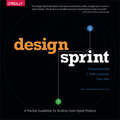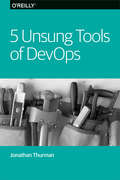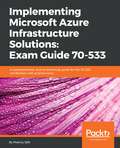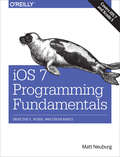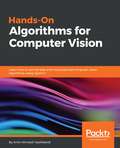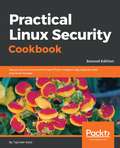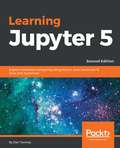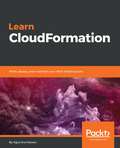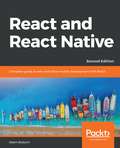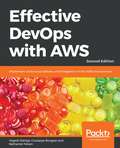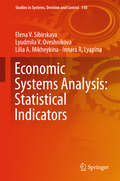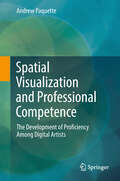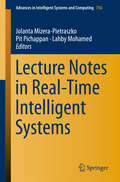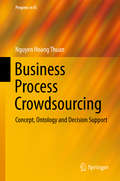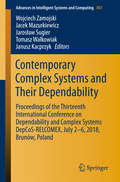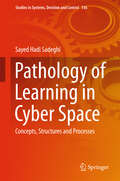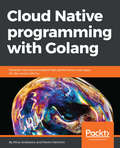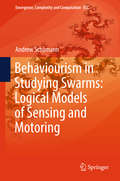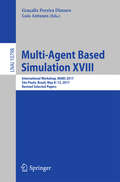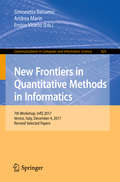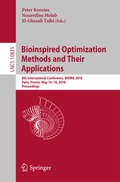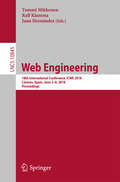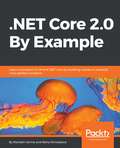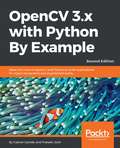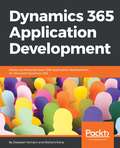- Table View
- List View
Design Sprint: A Practical Guidebook for Building Great Digital Products
by Trace Wax C. Todd Lombardo Richard BanfieldWith more than 500 new apps entering the market every day, what does it take to build a successful digital product? You can greatly reduce your risk of failure with design sprints, a process that enables your team to prototype and test a digital product idea within a week. This practical guide shows you exactly what a design sprint involves and how you can incorporate the process into your organization.Design sprints not only let you test digital product ideas before you pour too many resources into a project, they also help everyone get on board--whether they're team members, decision makers, or potential users. You'll know within days whether a particular product idea is worth pursuing.Design sprints enable you to:Clarify the problem at hand, and identify the needs of potential usersExplore solutions through brainstorming and sketching exercisesDistill your ideas into one or two solutions that you can testPrototype your solution and bring it to lifeTest the prototype with people who would use it
5 Unsung Tools of DevOps
by Jonathan ThurmanThe tools we use play a critical role in how effective we are. In today's ever-changing world of technology, we tend to focus on the latest and greatest solutions and overlook the simple tools that are available. Constant improvement of tools is an important aspect of the DevOps movement, but improvement doesn't always warrant replacement. The tools presented in 5 Unsung Tools of DevOps provide insight into or control over a DevOps environment--and they require minimal installation and configuration. They're not the flashiest tools, but they're time tested and just work.
Implementing Microsoft Azure Infrastructure Solutions: A comprehensive, end-to-end study guide for the 70-533 certification with practice tests
by Melony QinDevelop skills and knowledge for provisioning and managing services in Microsoft Azure and implement infrastructure componentsKey FeaturesBuild and manage robust infrastructure solutions on Microsoft AzurePlan and implement Azure storage, backup, and recovery servicesPrepare and boost your confidence with certification-based mock tests and solutionsBook DescriptionMicrosoft Azure is a prominent public cloud provider, recording the highest user base growth in the year 2017. Microsoft has prominent certifications that help architects, developers, and administrators gain hands-on knowledge while working on Azure. 70-533 is one such advanced-level certification, which deals with infrastructure solutions on Microsoft Azure.Implementing Microsoft Azure Infrastructure Solutions starts with an overview of the certification and an introduction to Microsoft Azure. Next, you will learn how to plan and implement virtual machines and containers, followed by designing and implementing service apps. As you make your way through the chapters, you will learn how to implement and manage virtual networks and Azure identities, as well as the Active Directory infrastructure in a hybrid environment. In the concluding chapters, you will learn how to plan and implement storage and security, and business continuity and disaster recovery (BCDR) strategies. You will also automate and monitor cloud management operations in Azure. By the end of the book, you will have covered all of the modules, along with the practice questions at the end of each chapter, which will be extremely helpful in passing the 70-533 certification exam.What you will learnExplore cloud basics and gain an overview of Microsoft AzurePlan and implement virtual machines and containers for scalability and resilienceUnderstand virtual networks' cross-premises connectivityLearn how to manage your Azure identitiesPlan and implement storage, security, and the BCDR strategyAutomate and monitor cloud management operations in AzureManage app services for resilience and availabilityInteracting with Azure Services by using ARM, the Azure CLI, and PowerShellWho this book is forImplementing Microsoft Azure Infrastructure Solutions is for senior cloud professionals who already have experience working with the Azure ecosystem and want to take their knowledge to the next level. Prior knowledge of the Azure ecosystem is necessary.
iOS 7 Programming Fundamentals: Objective-C, Xcode, and Cocoa Basics
by Matt NeuburgIf you're getting started with iOS development, or want a firmer grasp of the basics, this practical guide provides a clear view of its fundamental building blocks--Objective-C, Xcode, and Cocoa Touch. You'll learn object-oriented concepts, understand how to use Apple's development tools, and discover how Cocoa provides the underlying functionality iOS apps need to have. Dozens of example projects are available at GitHub. Once you master the fundamentals, you'll be ready to tackle the details of iOS app development with author Matt Neuburg's companion guide, Programming iOS 7--coming in December 2013. Explore the C language to learn how Objective-C works Learn how instances are created, and why they're so important Tour the lifecycle of an Xcode project, from inception to App Store Discover how to build interfaces with nibs and the nib editor Explore Cocoa's use of Objective-C linguistic features Use Cocoa's event-driven model and major design patterns Learn the role of accessors, key-value coding, and properties Understand the power of ARC-based object memory management Send messages and data between Cocoa objects
Hands-On Algorithms for Computer Vision: Learn how to use the best and most practical computer vision algorithms using OpenCV
by Amin Ahmadi TazehkandiCreate powerful, accurate, and real-time Computer Vision applications using a perfect blend of algorithms and filters. Also learn about object tracking and foreground extractions with a variety of new filters and algorithms.Key Features Filter, transform, and manipulate images using MAT class and OpenCV Framework Explore motion detection and object tracking with filters and algorithms Build object detectors using deep learning and machine learning algorithmsBook DescriptionAn arena that has been positively impacted by the advancements in processing power and performance is the field of computer vision. It's only natural that over time, more and more algorithms are introduced to perform computer vision tasks more efficiently. Hands-On Algorithms for Computer Vision is a starting point for anyone who is interested in the field of computer vision and wants to explore the most practical algorithms used by professional computer vision developers. The book starts with the basics and builds up over the course of the chapters with hands-on examples for each algorithm.Right from the start, you will learn about the required tools for computer vision development, and how to install and configure them. You'll explore the OpenCV framework and its powerful collection of libraries and functions. Starting from the most simple image modifications, filtering, and transformations, you will gradually build up your knowledge of various algorithms until you are able to perform much more sophisticated tasks, such as real-time object detection using deep learning algorithms.What you will learn Get to grips with machine learning and artificial intelligence algorithms Read, write, and process images and videos Perform mathematical, matrix, and other types of image data operations Create and use histograms from back-projection images Detect motion, extract foregrounds, and track objects Extract key points with a collection of feature detector algorithms Develop cascade classifiers and use them, and train and test classifiers Employ TensorFlow object detection to detect multiple objectsWho this book is forHands-On Algorithms for Computer Vision helps those who want to learn algorithms in Computer Vision to create and customize their applications. This book will also help existing Computer Vision developers customize their applications. A basic understanding of computer vision and programming experience is needed.
Practical Linux Security Cookbook: Secure your Linux environment from modern-day attacks with practical recipes, 2nd Edition
by Tajinder KalsiEnhance file system security and learn about network attack, security tools and different versions of Linux build.Key FeaturesHands-on recipes to create and administer a secure Linux systemEnhance file system security and local and remote user authenticationUse various security tools and different versions of Linux for different tasksBook DescriptionOver the last few years, system security has gained a lot of momentum and software professionals are focusing heavily on it. Linux is often treated as a highly secure operating system. However, the reality is that Linux has its share of security flaws, and these security flaws allow attackers to get into your system and modify or even destroy your important data. But there’s no need to panic, since there are various mechanisms by which these flaws can be removed, and this book will help you learn about different types of Linux security to create a more secure Linux system. With a step-by-step recipe approach, the book starts by introducing you to various threats to Linux systems. Then, this book will walk you through customizing the Linux kernel and securing local files. Next, you will move on to managing user authentication both locally and remotely and mitigating network attacks. Later, you will learn about application security and kernel vulnerabilities. You will also learn about patching Bash vulnerability, packet filtering, handling incidents, and monitoring system logs. Finally, you will learn about auditing using system services and performing vulnerability scanning on Linux.By the end of this book, you will be able to secure your Linux systems and create a robust environment.What you will learnLearn about vulnerabilities and exploits in relation to Linux systemsConfigure and build a secure kernel and test itLearn about file permissions and how to securely modify filesAuthenticate users remotely and securely copy files on remote systemsReview different network security methods and toolsPerform vulnerability scanning on Linux machines using toolsLearn about malware scanning and read through logsWho this book is forThis book is intended for all those Linux users who already have knowledge of Linux file systems and administration. You should be familiar with basic Linux commands. Understanding information security and its risks to a Linux system is also helpful in understanding the recipes more easily.
Learning Jupyter 5: Explore interactive computing using Python, Java, JavaScript, R, Julia, and JupyterLab, 2nd Edition
by Dan ToomeyCreate and share livecode, equations, visualizations, and explanatory text, in both a single document and a web browser with JupyterKey FeaturesLearn how to use Jupyter 5.x features such as cell tagging and attractive table stylesLeverage big data tools and datasets with different Python packagesExplore multiple-user Jupyter Notebook serversBook DescriptionThe Jupyter Notebook allows you to create and share documents that contain live code, equations, visualizations, and explanatory text. The Jupyter Notebook system is extensively used in domains such as data cleaning and transformation, numerical simulation, statistical modeling, and machine learning. Learning Jupyter 5 will help you get to grips with interactive computing using real-world examples.The book starts with a detailed overview of the Jupyter Notebook system and its installation in different environments. Next, you will learn to integrate the Jupyter system with different programming languages such as R, Python, Java, JavaScript, and Julia, and explore various versions and packages that are compatible with the Notebook system. Moving ahead, you will master interactive widgets and namespaces and work with Jupyter in a multi-user mode.By the end of this book, you will have used Jupyter with a big dataset and be able to apply all the functionalities you’ve explored throughout the book. You will also have learned all about the Jupyter Notebook and be able to start performing data transformation, numerical simulation, and data visualization.What you will learnInstall and run the Jupyter Notebook system on your machineImplement programming languages such as R, Python, Julia, and JavaScript with the Jupyter NotebookUse interactive widgets to manipulate and visualize data in real timeStart sharing your Notebook with colleaguesInvite your colleagues to work with you on the same NotebookOrganize your Notebook using Jupyter namespacesAccess big data in Jupyter for dealing with large datasets using SparkWho this book is forLearning Jupyter 5 is for developers, data scientists, machine learning users, and anyone working on data analysis or data science projects across different teams. Data science professionals will also find this book useful for performing technical and scientific computing collaboratively.
Learn CloudFormation: Write, deploy, and maintain your AWS infrastructure
by Agus KurniawanGet up and running with AWS automation using CloudFormationKey FeaturesExplore the fundamentals of AWS CloudFormationGet acquainted with concepts such as CloudFormation templates and mappingsLearn to implement Infrastructure as a Code (IaC) on AWSBook DescriptionAs the Amazon Web Services (AWS) infrastructure is gradually moving towards cloud, managing cloud-related tasks efficiently continues to be a challenge for system administrators. CloudFormation is a language developed for managing infrastructure-related services efficiently on AWS and its features help secure the AWS resource deployment process.Learn CloudFormation serves as a fundamental guide to kick-start your journey on CloudFormation. We will introduce you to the basic concepts on IaC and the AWS services required for implementing automation and infrastructure management. Then, we deep dive into concepts such as CloudFormation mapping, conditions, limit, and output and EC2. In the concluding chapters, you will manage the entire AWS infrastructure using CloudFormation templates.By the end of this book, you will get up and running with IaC with CloudFormation.What you will learnUnderstand AWS CloudFormationDevelop AWS CloudFormation templatesDeploy AWS CloudFormation for AWS resourcesBuild your first AWS CloudFormation projectExplore AWS Security featuresDeploy testing and production stages using CloudFormationWho this book is forLearn CloudFormation is for cloud engineers, system administrators, cloud architects, or any stakeholders working in the field of cloud development or cloud administration. Basic knowledge of AWS is necessary.
React and React Native: Complete guide to web and native mobile development with React, 2nd Edition
by Adam BoduchBuild applications for web and native mobile platforms with React, JSX, Redux, and GraphQLKey FeaturesExplore how functional web development works with React, Redux, and React NativeBuild apps with unified architecture with Facebook's React, Relay, and GraphQLUnderstand the platform in-depth, from routing to server-side rendering Book DescriptionThis books takes you through using React 16 and React Native 0.5 to create powerful and engaging desktop mobile and native applications for all platforms.You start by learning how to craft composable UIs using React, ranging from rendering with JSX and creating reusable components to routing and creating isomorphic applications that run on Node.js.We then move on to show you how to take the concepts of React and apply them to building Native UIs using React Native. You'll find out how to build responsive and streamlined UIs that can properly handle user interactions in a mobile environment. You'll also learn how to access device-specific APIs such as the Geolocation API, and how to handle offline development with React Native. You will master handling application state, Unified Information Architecture, and using Flux, Redux, and Relay. Towards the end of the book, you will learn how Flux ideas are encapsulated within React components using Relay and apply all the skills learned so far to create a React application that runs on every major platform.What you will learnLearn what has changed in React 16 and how you stand to benefitCraft reusable components using the React virtual DOM Learn how to use the new create-react-native-app command line toolAugment React components with GraphQL for data using RelayHandle state for architectural patterns using FluxBuild an application for web UIs using Relay Who this book is forThis book is written for any JavaScript developer—beginner or expert—who wants to start learning how to put both of Facebook’s UI libraries to work. No knowledge of React is needed, though a working knowledge of ES2017 will help you follow along better.
Effective DevOps with AWS: Implement continuous delivery and integration in the AWS environment, 2nd Edition
by Nathaniel Felsen Giuseppe Borgese Yogesh RahejaScale and maintain outstanding performance in your AWS-based infrastructure using DevOps principlesKey FeaturesImplement continuous integration and continuous deployment pipelines on AWSGain insight from an expert who has worked with Silicon Valley's most high-profile companiesImplement DevOps principles to take full advantage of the AWS stack and servicesBook DescriptionThe DevOps movement has transformed the way modern tech companies work. Amazon Web Services (AWS), which has been at the forefront of the cloud computing revolution, has also been a key contributor to the DevOps movement, creating a huge range of managed services that help you implement DevOps principles.Effective DevOps with AWS, Second Edition will help you to understand how the most successful tech start-ups launch and scale their services on AWS, and will teach you how you can do the same. This book explains how to treat infrastructure as code, meaning you can bring resources online and offline as easily as you control your software. You will also build a continuous integration and continuous deployment pipeline to keep your app up to date. Once you have gotten to grips will all this, we'll move on to how to scale your applications to offer maximum performance to users even when traffic spikes, by using the latest technologies, such as containers. In addition to this, you'll get insights into monitoring and alerting, so you can make sure your users have the best experience when using your service. In the concluding chapters, we'll cover inbuilt AWS tools such as CodeDeploy and CloudFormation, which are used by many AWS administrators to perform DevOps. By the end of this book, you'll have learned how to ensure the security of your platform and data, using the latest and most prominent AWS tools.What you will learnImplement automatic AWS instance provisioning using CloudFormationDeploy your application on a provisioned infrastructure with AnsibleManage infrastructure using TerraformBuild and deploy a CI/CD pipeline with Automated Testing on AWSUnderstand the container journey for a CI/CD pipeline using AWS ECSMonitor and secure your AWS environmentWho this book is forEffective DevOps with AWS is for you if you are a developer, DevOps engineer, or you work in a team which wants to build and use AWS for software infrastructure. Basic computer science knowledge is required to get the most out of this book.
Economic Systems Analysis: Statistical Indicators (Studies in Systems, Decision and Control #158)
by Innara R. Lyapina Lilia A. Mikheykina Lyudmila V. Oveshnikova Elena V. SibirskayaThis book explores a wide range of issues related to the methodology, organization, and technologies of analytical work, showing the potential of using analytical tools and statistical indicators for studying socio-economic processes, forecasting, organizing effective companies, and improving managerial decisions. At the level of “living knowledge” in the broad context, it describes the essence of analytical technologies and means of applying analytical and statistical work. The book is of interest to readers regardless of their specialization: scientific research, medicine, pedagogics, law, administrative work, or economic practice. Starting from the premise that readers are familiar with the theory of statistics, which has formulated the general methods and principles of establishing the quantitative characteristics of mass phenomena and processes, it describes the concepts, definitions, indicators and classifications of socio-economic statistics, taking into consideration the international standards and the present-day practice of statistics in Russia. Although concise, the book provides plenty of study material as well as questions at the end of each chapter It is particularly useful for those interested in self-study or remote education, as well as business leaders who are interested in gaining a scientific understanding of their financial and economic activities.
Spatial Visualization and Professional Competence: The Development Of Proficiency Among Digital Artists
by Andrew PaquetteThe computer graphics (CG) industry is an attractive field for undergraduate students, but employers often find that graduates of CG art programmes are not proficient. The result is that many positions are left vacant, despite large numbers of job applicants. This book investigates how student CG artists develop proficiency. The subject is important to the rapidly growing number of educators in this sector, employers of graduates, and students who intend to develop proficiency for the purpose of obtaining employment. Educators will see why teaching software-oriented knowledge to students does not lead to proficiency, but that the development of problem-solving and visualisation skills do. This book follows a narrow focus, as students develop proficiency in a cognitively challenging task known as ‘NURBS modelling’. This task was chosen due to an observed relationship between students who succeeded in the task, and students who successfully obtained employment after graduation. In the study this is based on, readers will be shown that knowledge-based explanations for the development of proficiency do not adequately account for proficiency or expertise in this field, where visualisation has been observed to develop suddenly rather than over an extended period of time. This is an unusual but not unique observation. Other studies have shown rapid development of proficiency and expertise in certain professions, such as among telegraph operators, composers and chess players. Based on these observations, the book argues that threshold concepts play a key role in the development of expertise among CG artists.
Lecture Notes in Real-Time Intelligent Systems (Advances In Intelligent Systems And Computing #756)
by Lahby Mohamed Pit Pichappan Jolanta Mizera-PietraszkoThe second volume of the book series highlights works presented at the 2nd International Conference on Real Time Intelligent Systems, held in Casablanca on October 18-20, 2017. The book offers a comprehensive, practical review of the state-of-the-art in designing and implementing real-time intelligent computing for the areas within the conference’s scope such as robotics, intelligent alert systems, IoT, remote access control, multi-agent systems, networking, mobile smart systems, crowdsourcing, broadband systems, cloud computing, streaming data and many other applications. Research in real-time computing supports decision making in dynamic environments. Some examples include ABS, FBW flight control, automatic air-conditioning, etc. Intelligent computing relies heavily on artificial intelligence (AI) to make computers act for humans. The authors are confident that the solutions discussed in this book will provide a unique source of information and inspiration for researchers working in AI, distributed coding algorithms or smart services and platforms, and for IT professionals, who can integrate the proposed methods into their practice.
Business Process Crowdsourcing: Concept, Ontology And Decision Support (Progress in IS)
by Nguyen Hoang ThuanThis book conceptualises and develops crowdsourcing as an organisational business process. It argues that although for many organisations crowdsourcing still implies an immature one-off endeavour, when developed to a more repeatable business process it can harness innovation and agility. The book offers a process model to guide organisations towards the establishment of business process crowdsourcing (BPC), and empirically showcases and evaluates the model using two current major crowdsourcing projects. In order to consolidate the domain knowledge, the BPC model is turned into a heavyweight ontology capturing the concepts, hierarchical relationships and decision-making relationships necessary to establish crowdsourcing as a business process in an organisation. Lastly, based on the ontology it presents a decision tool that provides advice on making informed decisions about the performance of business process crowdsourcing activities.
Contemporary Complex Systems and Their Dependability: Proceedings Of The Thirteenth International Conference On Dependability And Complex Systems Depcos-relcomex. July 2 - 6, 2018, Brunów, Poland (Advances In Intelligent Systems And Computing #761)
by Tomasz Walkowiak Jarosław Sugier Jacek Mazurkiewicz Wojciech Zamojski Janusz KacprzykThis book presents the proceedings of the Thirteenth International Conference on Dependability and Complex Systems (DepCoS-RELCOMEX), which took place in the Brunów Palace in Poland from 2nd to 6th July 2018. The conference has been organized at the Faculty of Electronics, Wrocław University of Science and Technology since 2006, and it continues the tradition of two other events: RELCOMEX (1977–89) and Microcomputer School (1985–95). The selection of papers in these proceedings illustrates the broad variety of topics that are investigated in dependability analyses of today’s complex systems. Dependability came naturally as a contemporary answer to new challenges in the reliability evaluation of these systems. Such systems cannot be considered only as structures (however complex and distributed) built on the basis of technical resources (hardware): their analysis must take into account a unique blend of interacting people (their needs and behaviours), networks (together with mobile properties, cloud-based systems) and a large number of users dispersed geographically and producing an unimaginable number of applications (working online). A growing number of research methods apply the latest advances in artificial intelligence (AI) and computational intelligence (CI). Today’s complex systems are really complex and are applied in numerous different fields of contemporary life.
Pathology of Learning in Cyber Space: Concepts, Structures And Processes (Studies in Systems, Decision and Control #156)
by Sayed Hadi SadeghiThis book is divided into seven chapters, beginning with discussions of the main concepts of cyberspace, the relationship between cyberspace and real space, learning and education. It describes the relationship between cyberspace and real space, and presents capacities, judiciary, and concepts related to cyberspace. Cyber curricular education forms are then described in terms of teaching and learning resources in cyberspace. The discussion presented in this book consists of two main sections: The first section, outlines the objectives of training in cyberspace at different levels, while the second section describes the injuries caused by learning and training in cyberspace at different levels, and then highlights how cyber training is handled and receives feedback. Lastly, the authors provide a summary of the topics presented. Most other discussions are general and present the overall benefits of e-learning and e-teaching that is formally carried out in universities and schools through cyberspace. But, unfortunately, none of them fully explores the learning, education and cyber-training resources which should be used by individuals, groups, organizations, governments, and others in pursuing to achieve their goals. In addition to this, they do not pay much attention to the challenges and injuries caused by learning and teaching in cyberspace. This has led the authors to investigate these and other issues related to learning and training in cyberspace more widely and comprehensively, and also consider them beyond official formal learning and education. Most importantly they address issues such as the injuries and challenges that, in different ways and at different levels result from learning and education in this space. As such this book goes beyond simple and repetitive issues that have been raised concerning cyberspace, and underlines the challenges it poses. Although intended for scholars and students from the fields of science education, information technology, sociology and educational technology as well as interested parties and related authorities, this book is also helpful for people wishing to better understand new topics, such as cyberspace, learning and training in cyberspace, and related issues. It is of interest to a wide range of enthusiasts, with different educational, specialist and executive backgrounds, including academics, policymakers, managers and planners from educational and cultural institutions
Cloud Native programming with Golang: Develop microservice-based high performance web apps for the cloud with Go
by Jelmer Snoeck Mina Andrawos Martin HelmichKey Features Build well-designed and secure microservices. Enrich your microservices with continous integration and monitoring. Containerize your application with Docker Deploy your application to AWS. Learn how to utilize the powerful AWS services from within your application Book Description Cloud computing and microservices are two very important concepts in modern software architecture. They represent key skills that ambitious software engineers need to acquire in order to design and build software applications capable of performing and scaling. Go is a modern cross-platform programming language that is very powerful yet simple; it is an excellent choice for microservices and cloud applications. Go is gaining more and more popularity, and becoming a very attractive skill.. The book will take you on a journey into the world of microservices and cloud computing with the help of Go. It will start by covering the software architectural patterns of cloud applications, as well as practical concepts regarding how to scale, distribute, and deploy those applications. You will also learn how to build a JavaScript-based front-end for your application, using TypeScript and React. From there, we dive into commercial cloud offerings by covering AWS. Finally, we conclude our book by providing some overviews of other concepts and technologies that the reader can explore to move from where the book leaves off. What you will learn Understand modern software applications architectures Build secure microservices that can effectively communicate with other services Get to know about event-driven architectures by diving into message queues such as Kafka, Rabbitmq, and AWS SQS. Understand key modern database technologies such as MongoDB, and Amazon’s DynamoDB Leverage the power of containers Explore Amazon cloud services fundamentals Know how to utilize the power of the Go language to access key services in the Amazon cloud such as S3, SQS, DynamoDB and more. Build front-end applications using ReactJS with Go Implement CD for modern applications
Behaviourism in Studying Swarms: Logical Models of Sensing and Motoring (Emergence, Complexity And Computation Ser. #33)
by Andrew SchumannThis book presents fundamental theoretical results for designing object-oriented programming languages for controlling swarms. It studies the logics of swarm behaviours. According to behaviourism, all behaviours can be controlled or even managed by stimuli in the environment: attractants (motivational reinforcement) and repellents (motivational punishment). At the same time, there are two main stages in reactions to stimuli: sensing (perceiving signals) and motoring (appropriate direct reactions to signals). This book examines the strict limits of behaviourism from the point of view of symbolic logic and algebraic mathematics: how far can animal behaviours be controlled by the topology of stimuli? On the one hand, we can try to design reversible logic gates in which the number of inputs is the same as the number of outputs. In this case, the behaviouristic stimuli are inputs in swarm computing and appropriate reactions at the motoring stage are its outputs. On the other hand, the problem is that even at the sensing stage each unicellular organism can be regarded as a logic gate in which the number of outputs (means of perceiving signals) greatly exceeds the number of inputs (signals).
Multi-Agent Based Simulation XVIII: International Workshop, Mabs 2017, São, Brazil, May 8-12. 2017, Revised Selected Papers (Lecture Notes in Computer Science #10798)
by Luis Antunes Graçaliz Pereira DimuroThis book constitutes the thoroughly refereed post-conference proceedings of the 18th International Workshop on Multi-Agent-Based Simulation, MABS 2017, held in Sao Paulo, Brazil, in May 2017. The workshop was held in conjunction with the 16th International Conference on Autonomous Agents and Multi-Agent Systems, AAMAS 2017. The 15 revised full papers included in this volume were carefully selected from 23 submissions. The topic of the papers is about applying agent-based simulation techniques to real-world problems focusing on the confluence of socio-technical-natural sciences and multi-agent systems with a strong application/empirical vein.
New Frontiers in Quantitative Methods in Informatics: 7th Workshop, Infq 2017, Venice, Italy, December 4, 2017, Revised Selected Papers (Communications In Computer And Information Science #825)
by Enrico Vicario Andrea Marin Simonetta BalsamoThis book constitutes the refereed proceedings of the 7th Workshop on New Frontiers in Quantitative Methods in Informatics, InfQ 2017, held in Venice, Italy, in December 2017.The 11 revised full papers and the one revised short paper presented were carefully reviewed and selected from 22 submissions. The papers are organized in topical sections on networking and mobile applications; applications of quantitative modeling; big data processing and IoT; theory, methods and tools for quantitative analysis.
Bioinspired Optimization Methods and Their Applications: 8th International Conference, Bioma 2018, Paris, France, May 16-18, 2018, Proceedings (Lecture Notes in Computer Science #10835)
by El-Ghazali Talbi Nouredine Melab Peter KorošecThis book constitutes the thoroughly refereed revised selected papers of the 10th International Conference on Bioinspired Optimization Models and Their Applications, BIOMA 2018, held in Paris, France, in May 2018. The 27 revised full papers were selected from 53 submissions and present papers in all aspects of bioinspired optimization research such as new algorithmic developments, high-impact applications, new research challenges, theoretical contributions, implementation issues, and experimental studies.
Web Engineering: 18th International Conference, Icwe 2018, Cáceres, Spain, June 5-8, 2018, Proceedings (Theoretical Computer Science and General Issues #10845)
by Juan Hernández Ralf Klamma Tommi MikkonenThis book constitutes the refereed proceedings of the 18th International Conference on Web Engineering, ICWE 2018, held in Cáceres, Spain, in June 2018.The 18 full research papers and 17 short papers presented together with 2 practice papers, 6 demonstration papers, and 5 tutorials were carefully reviewed and selected from 103 submissions. The papers cover research areas such as Web application modeling and engineering; Web infrastructures and architectures; execution models; human computation and crowdsourcing applications; Web application composition and mashups; Social Web applications; Semantic Web applications; Web of Things applications; big data and data analytics; and security, privacy, and identity.
.NET Core 2.0 By Example: Learn to program in C# and .NET Core by building a series of practical, cross-platform projects
by Neha Shrivastava Rishabh VermaBuild cross-platform solutions with .NET Core 2.0 through real-life scenariosKey Features Bridges the gap between learning and doing and improves your software development skills Covers the best practices of .NET development to improve your productivity Example-based approach to get you started quickly with software programmingBook DescriptionWith the rise in the number of tools and technologies available today, developers and architects are always exploring ways to create better and smarter solutions. Before, the differences between target platforms was a major roadblock, but that's not the case now. .NET Core 2.0 By Example will take you on an exciting journey to building better software.This book provides fresh and relevant content to .NET Core 2.0 in a succinct format that’s enjoyable to read. It also delivers concepts, along with the implications, design decisions, and potential pitfalls you might face when targeting Linux and Windows systems, in a logical and simple way.With the .NET framework at its center, the book comprises of five varied projects: a multiplayer Tic-tac-toe game; a real-time chat application, Let'sChat; a chatbot; a microservice-based buying-selling application; and a movie booking application. You will start each chapter with a high-level overview of the content, followed by the above example applications described in detail. By the end of each chapter, you will not only be proficient with the concepts, but you’ll also have created a tangible component in the application.By the end of the book, you will have built five solid projects using all the tools and support provided by the .NET Core 2.0 framework.What you will learn Build cross-platform applications with ASP.NET Core 2.0 and its tools Integrate, host, and deploy web apps with the cloud (Microsoft Azure) Leverage the ncurses native library to extend console capabilities in .NET Core on Linux and interop with native coden .NET Core on Linux and learn how to interop with existing native code Reuse existing .NET Framework and Mono assemblies from .NET Core 2.0 applications Develop real-time web applications using ASP.NET Core Learn the differences between SOA and microservices and get started with microservice development using ASP.NET Core 2.0 Walk through functional programming with F# and .NET Core from scratchWho this book is forIf you are a developer or architect and want to learn how to build cross-platform solutions using Microsoft .NET Core, this book is for you. It is assumed that you have some knowledge of the .NET Framework, OOP, and C# (or a similar programming language).
OpenCV 3.x with Python By Example: Make the most of OpenCV and Python to build applications for object recognition and augmented reality
by Gabriel Garrido Calvo Naren Yellavula Prateek JoshiLearn the techniques for object recognition, 3D reconstruction, stereo imaging, and other computer vision applications using examples on different functions of OpenCV. Key Features Learn how to apply complex visual effects to images with OpenCV 3.x and Python Extract features from an image and use them to develop advanced applications Build algorithms to help you understand image content and perform visual searches Get to grips with advanced techniques in OpenCV such as machine learning, artificial neural network, 3D reconstruction, and augmented reality Book Description Computer vision is found everywhere in modern technology. OpenCV for Python enables us to run computer vision algorithms in real time. With the advent of powerful machines, we have more processing power to work with. Using this technology, we can seamlessly integrate our computer vision applications into the cloud. Focusing on OpenCV 3.x and Python 3.6, this book will walk you through all the building blocks needed to build amazing computer vision applications with ease. We start off by manipulating images using simple filtering and geometric transformations. We then discuss affine and projective transformations and see how we can use them to apply cool advanced manipulations to your photos like resizing them while keeping the content intact or smoothly removing undesired elements. We will then cover techniques of object tracking, body part recognition, and object recognition using advanced techniques of machine learning such as artificial neural network. 3D reconstruction and augmented reality techniques are also included. The book covers popular OpenCV libraries with the help of examples. This book is a practical tutorial that covers various examples at different levels, teaching you about the different functions of OpenCV and their actual implementation. By the end of this book, you will have acquired the skills to use OpenCV and Python to develop real-world computer vision applications. What you will learn Detect shapes and edges from images and videos How to apply filters on images and videos Use different techniques to manipulate and improve images Extract and manipulate particular parts of images and videos Track objects or colors from videos Recognize specific object or faces from images and videos How to create Augmented Reality applications Apply artificial neural networks and machine learning to improve object recognitionWho this book is for This book is intended for Python developers who are new to OpenCV and want to develop computer vision applications with OpenCV and Python. This book is also useful for generic software developers who want to deploy computer vision applications on the cloud. It would be helpful to have some familiarity with basic mathematical concepts such as vectors, matrices, and so on.
Dynamics 365 Application Development: Master professional-level CRM application development for Microsoft Dynamics 365
by Deepesh Somani Nishant RanaLearn, develop, and design applications using the new features in Microsoft Dynamics CRM Key Features - Implement business logic using processes, plugins, and client-side scripts with MS Dynamics 365 - Develop custom CRM solutions to improve your business applications - A comprehensive guide that covers the new features of Microsoft Dynamics 365 and increasingly advanced topics. Book Description Microsoft Dynamics 365 CRM is the most trusted name in enterprise-level customer relationship management. Thelatest version of Dynamics CRM comes with the important addition of exciting features guaranteed to make your life easier. It comes straight off the shelf with a whole new frontier of updated business rules, process enhancements, SDK methods, and other enhancements. This book will introduce you to the components of the new designer tools, such as SiteMap, App Module, and Visual Designer for Business Processes. Going deeper, this book teaches you how to develop custom SaaS applications leveraging the features of PowerApps available in Dynamics 365.Further, you will learn how to automate business processes using Microsoft Flow, and then we explore Web API, the most important platform update in Dynamics 365 CRM. Here, you'll also learn how to implement Web API in custom applications. You will learn how to write an Azure-aware plugin to design and integrate cloud-aware solutions. The book concludes with configuring services using newly released features such as Editable grids, Data Export Service, LinkedIn Integration, Relationship Insights, and Live Assist. What you will learn - Discover new designers tools included in Dynamics 365 CRM - Develop apps using the platform-agnostic Web API - Leverage Azure Extensions to design cloud-aware applications - Learn how to implement CRUD operation - Create integrated real-world apps using Microsoft PowerApps and Flow by combining services such as Twitter, Facebook, and SharePoint - Configure and use Artificial Intelligence Azure Cognitive Services for Recommendation and Text Analytic servicesWho this book is for This book targets skilled developers who are looking to build business-solution software and are new to application development in Microsoft Dynamics 365, especially for CRM.
